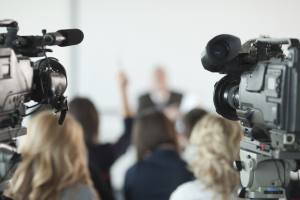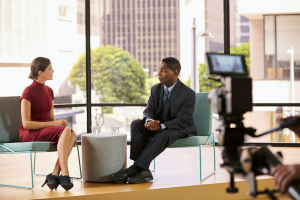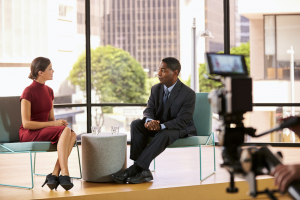-
.
Displaying items by tag: media training
Podcast interview with Presenter Trainer Gareth - The Presenter Studio
Our own Gareth had a great chat on the Chatterbeans podcast recently. Talking all things presenting, TV and career.
Take a look here: https://www.chatter-beans.com/latest-episodes
It was so much fun to do!
Use Silence to Speak with Impact - Media Interview Techniques
Why Energy Matters in Media Interviews - Media Training Tips
When it comes to media training, people often focus on what they say. But how you say it is just as important. And that’s where energy comes in.
Energy isn’t about being loud or over the top—it’s about showing that you care. When your voice has life, your eyes are engaged, and you’re actively involved in the conversation, the audience is far more likely to trust and believe you.
TV and radio have a way of flattening everything. So the energy you feel on the inside often doesn’t come across unless you deliberately turn it up a notch. That’s why media training sessions often feel like performance coaching. You need to lift your delivery, bring pace and contrast, and make sure your enthusiasm shines through.
This is especially true if the topic is serious or technical. Energy is what cuts through. It makes people want to listen. And crucially, it makes you feel more confident too.
So next time you’re prepping for an interview, don’t just script your message. Rehearse how you’re going to deliver it—with the energy it deserves.
For more information about our training programmes visit:
https://www.presenterstudio.com/business-presenter-training/media-training
Media Training - Wear Something That Reflects the Tone and Feel of Your Brand
In media appearances, how you look matters – not just in terms of style, but in terms of story. Your clothes send a message. They say something before you’ve even opened your mouth. So what are they saying about your brand?
At The Presenter Studio, one of the first things we ask clients is: Does what you’re wearing reflect the tone and feel of your business? For example, if you’re a relaxed, creative founder, a stiff suit might make you look out of step with your brand identity. Equally, if you’re representing a high-end corporate firm, a casual t-shirt might feel off-brand or unprepared.
Your appearance should support – not contradict – your message. It’s not about fashion. It’s about consistency. Colour, texture, formality, accessories – all these elements help create a visual impression that needs to align with how you want to be perceived.
And it’s not just about the brand. It’s about you, too. You need to feel comfortable and confident. Clothes that feel unfamiliar or awkward will impact how you move, how you sit, how you speak. The best on-camera looks are those that make you feel like the best version of yourself.
In our media training at The Presenter Studio, we offer advice not just on performance, but on styling – what works on camera, what to avoid, and how to find the sweet spot between your brand and your personality. Whether it’s a big studio interview or a social media video, we help you look the part and own the room.
To find out more about how we can prepare you for success in the spotlight, head to: https://www.presenterstudio.com/business-presenter-training/media-training
Media Training - Think of the Camera as a Real Person
Facing a camera can feel unnatural. There's no eye contact, no nodding head, no visible reaction – just a black lens staring back at you. It's no wonder many people freeze, overthink their delivery, or come across as wooden on screen. But here’s one of the most effective – and surprisingly simple – techniques we teach at The Presenter Studio: treat the camera as if it were a real person.
Imagine the camera is your best client, your most engaged colleague, or your most supportive friend. The goal is to create a genuine connection. When you shift your mindset away from ‘broadcasting’ and toward ‘communicating’, your tone naturally becomes warmer, your delivery more relaxed, and your performance more authentic.
Why does this matter? Because viewers can instantly tell when something feels rehearsed or robotic. The magic of great on-camera presence lies in making the audience feel like you’re speaking directly to them, not just delivering a message. Eye-line, tone, and intention all improve when you stop seeing the lens as a threat and start seeing it as a human.
At The Presenter Studio, our clients often find that this one mental shift unlocks a whole new level of confidence. We use practical exercises and personalised coaching to help them come across as natural and connected – even when the red light is on.
If you’d like to feel more at ease on camera and learn techniques used by top broadcasters and business leaders, explore our media training services at: https://www.presenterstudio.com/business-presenter-training/media-training
Presentation Skills Courses That Actually Work - Here’s Why
So many people come to us saying they’ve been on a presentation skills course before—but nothing really changed. That’s often because traditional training focuses on surface-level fixes. At The Presenter Studio, we dig deeper.
We understand that presentation anxiety, poor structure or a lack of clarity often come from a disconnect between what you want to say and how you’re trying to say it. Our courses address both sides of the equation: what you’re presenting and how you’re performing it.
We start by helping you find your natural communication style. Then we work on building tools around that style so your presentations feel authentic, not rehearsed. Our clients range from CEOs to first-time speakers, and we shape each session to match individual needs. With us, you’re not just learning how to stand in front of a room—you’re learning how to own it.
From storytelling techniques to handling difficult questions, our courses equip you with the confidence and strategies to succeed. And the feedback speaks for itself—people leave our training sessions with not just skills, but a whole new mindset.
More info at: https://www.presenterstudio.com/business-presenter-training/presentation-skills-training
What to Expect from a Presentation Skills Course with The Presenter Studio
Choosing the right presentation skills course can be tricky. Many promise big results, but few deliver on real impact. At The Presenter Studio, we’ve designed our courses around how people really learn—through doing, through feedback and through expert guidance that fits your unique voice.
Our training combines storytelling, body language, vocal techniques and content structuring. But what sets us apart is how personalised it is. We don’t offer cookie-cutter solutions. Instead, we work with who you are and where you want to go. Whether you need to lead internal meetings or deliver keynote speeches, our sessions are tailored to your real-world needs.
You’ll work with TV directors and communication coaches who bring out your best. They’ll help you think like a performer—so you not only inform but also inspire. Every exercise is rooted in performance psychology and media presentation techniques, refined over years of working with high-profile clients.
If you’re looking for a course that respects your individuality and boosts your presence, The Presenter Studio is here to help.
Visit: https://www.presenterstudio.com/business-presenter-training/presentation-skills-training
Why a Presentation Skills Course Could Be the Game-Changer You Need
For many professionals, presenting can be a nerve-wracking part of the job. Whether you're pitching ideas in a boardroom or addressing a virtual team meeting, strong presentation skills can set you apart. But these skills aren’t something you're born with—they're learned, developed and fine-tuned.
That’s where a presentation skills course comes in. At The Presenter Studio, we bring a unique, real-world approach. Unlike generic workshops, our training is created by TV professionals who know what it takes to engage an audience. It's not about being perfect; it's about being authentic, clear and confident.
We focus on practical tools that suit your style. From structuring your content to finding your natural performance, our coaching helps you create presentations that people remember for the right reasons. It’s ideal for professionals at any stage—whether you dread public speaking or want to polish your delivery for high-stakes moments.
When done right, a presentation skills course is more than a one-off workshop—it’s a turning point in how you communicate.
Learn more at: https://www.presenterstudio.com/business-presenter-training/presentation-skills-training
Media Training, Public Speaking
If you're representing your brand in the media, you’re also speaking in public – just to a much bigger, often unseen audience. That’s why media training and public speaking skills are closely connected. Our course helps you master both, so you can feel at ease whether you're on stage, in a studio, or speaking to camera.
Great public speakers know how to hold attention. Great media spokespeople know how to land messages. In our sessions, we combine both disciplines – helping you feel in control of your voice, message and delivery.
A key part of this course is presence. We work on breath, pace, and pauses to give your voice authority and variation. We also explore how to stand or sit with presence – without stiffness – so your body language matches your message.
In the media, you rarely get a second chance. That’s why we train you to think in short, sharp soundbites. This means cutting out jargon, simplifying your message, and using clear, emotive language that sticks.
Another powerful tool we teach is storytelling. Whether it’s a keynote or a media interview, stories humanise your message and create emotional connection. We show you how to use personal anecdotes, case studies, or simple metaphors to make your points come alive.
Our course also covers media interview formats – from hostile questions to friendly chats – and how to adjust your delivery for each.
With our coaching, you’ll develop a consistent, confident speaking style that works across every platform and performance.
Take the first step towards becoming the spokesperson your brand deserves: https://www.presenterstudio.com/business-presenter-training/media-training
How to Prepare for a Media Interview
Facing a media interview can feel daunting, especially if it’s live. But with the right preparation, you can feel confident and ready to handle whatever comes your way.
The first step is to get clear on your message. Before you go into any interview, ask yourself what the takeaway should be for the audience. What do you want them to remember? What impression do you want to leave? From there, you can build short, focused answers that deliver impact.
Next, consider how your answers might sound out loud. Speak them aloud, not just in your head. Practice turning points into short, conversational soundbites. The media loves clarity and brevity. Think about examples or personal stories that support your message. People connect with stories far more than statistics.
It’s also important to anticipate the questions. Some may be easy. Others may be more probing. Think about what you’re likely to be asked and how you’ll respond. If a difficult subject comes up, stay calm. Acknowledge the point, then return to your key message.
Lastly, your tone and body language matter just as much as your words. Keep eye contact, sit with relaxed energy, and speak at a steady pace. Even on radio, your voice will reflect how you’re feeling. Calm, confident energy builds trust.
At Presenter Studio, we help clients feel media-ready, whatever the situation. Whether you’re going on camera or speaking to press, our media training gives you the tools to own your message and stay in control. Learn more here: https://www.presenterstudio.com/business-presenter-training/media-training









